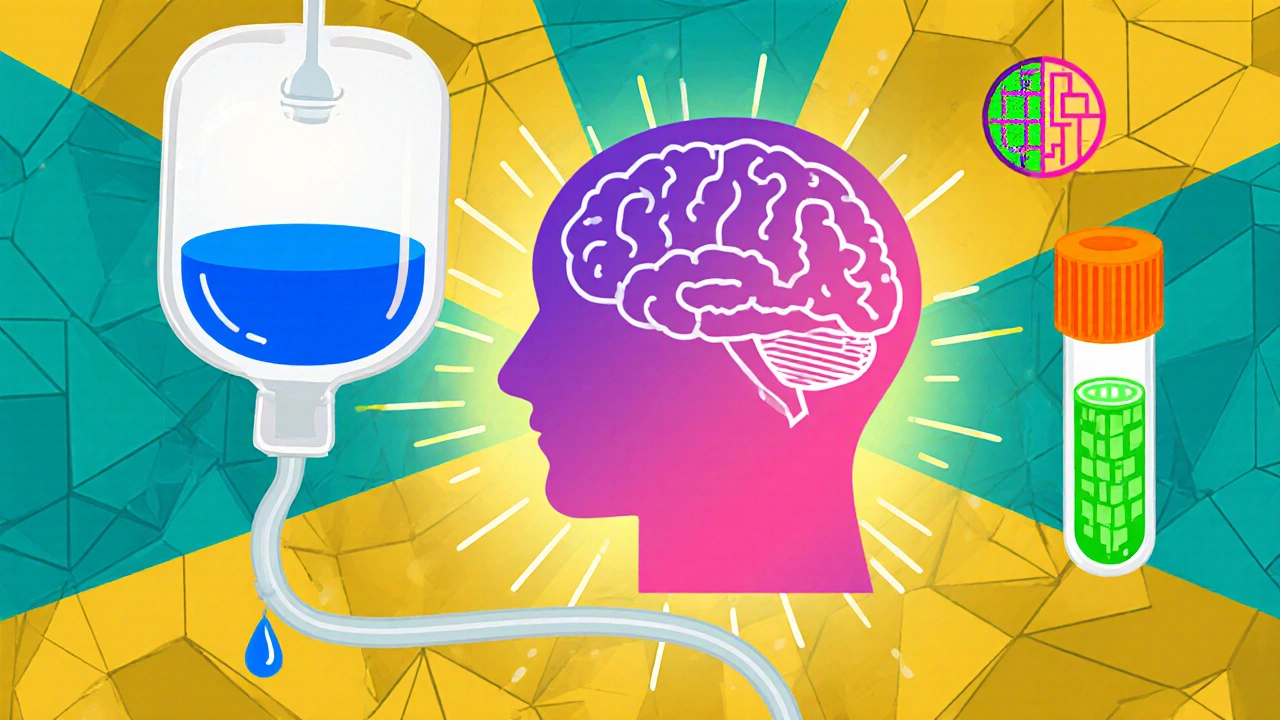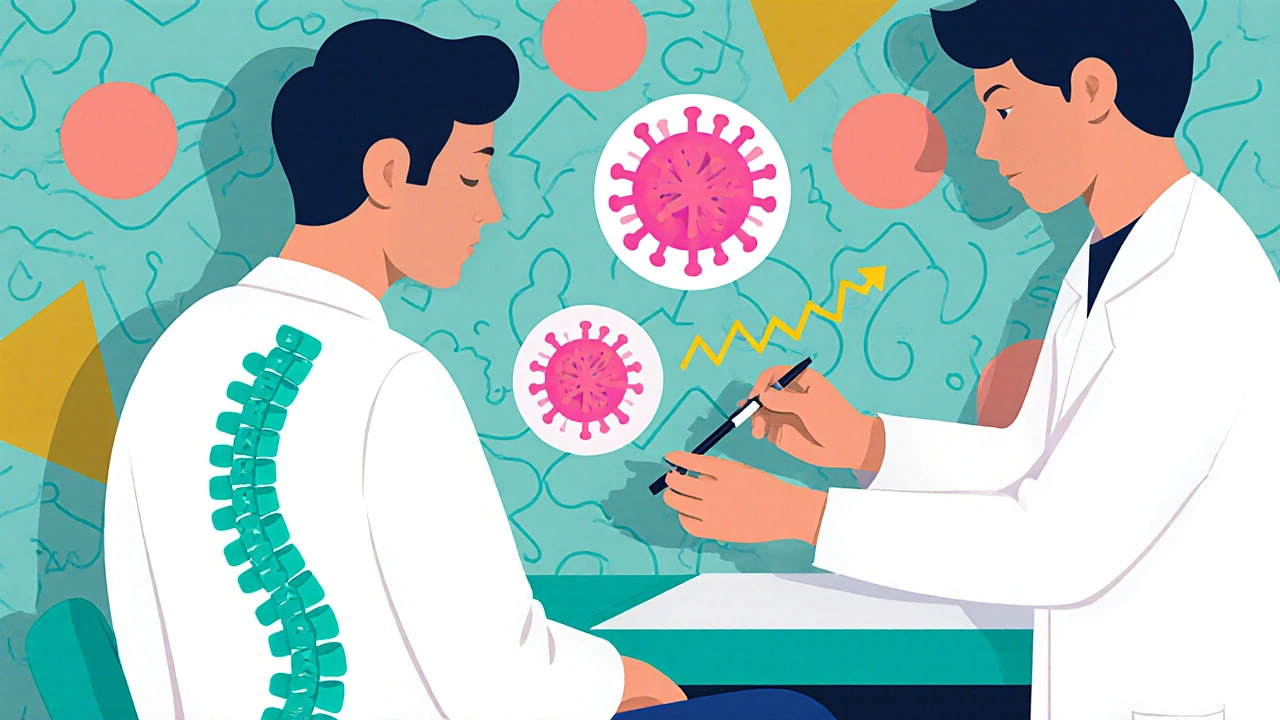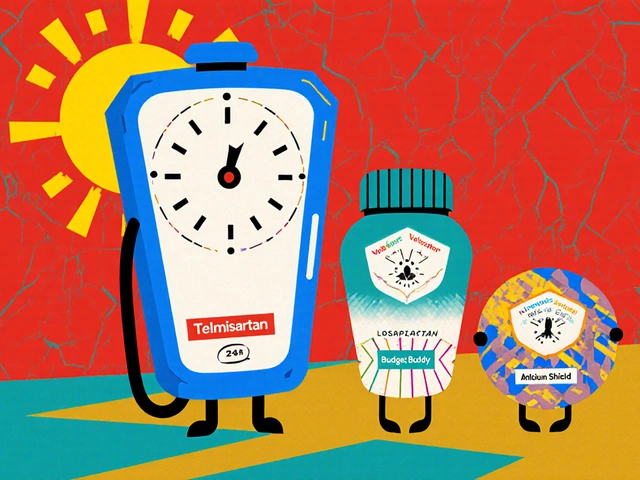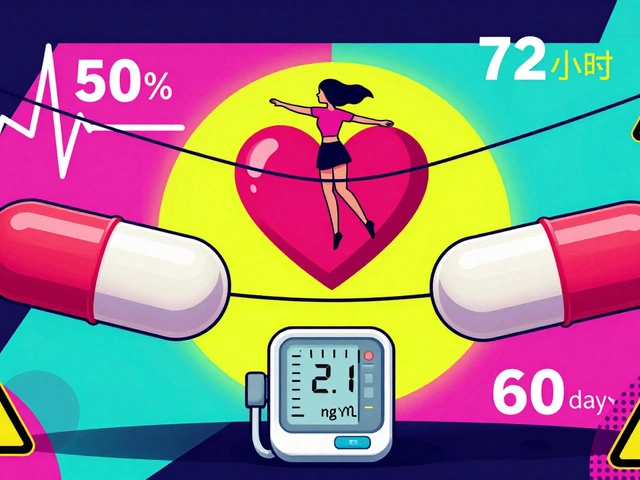Mollaret's meningitis is a form of recurrent aseptic meningitis most often triggered by reactivation of Herpes simplex virus (HSV‑2). Patients experience sudden headaches, fever, neck stiffness, and cerebrospinal fluid (CSF) inflammation that resolves spontaneously, only to recur weeks or months later. Though rare, the condition is acyclovir‑responsive, making early antiviral therapy essential for preventing complications and reducing episode frequency.
Key Takeaways
- Mollaret's meningitis is usually caused by HSV‑2 and presents with sterile CSF pleocytosis.
- Prompt diagnosis relies on lumbar puncture, CSF analysis, and PCR testing for HSV DNA.
- Standard acyclovir dosing is 10‑15 mg/kg IV every 8 hours for 10‑14 days, with oral step‑down when appropriate.
- Monitor renal function and adjust dosing in patients with impaired clearance.
- Alternative antivirals (valacyclovir, famciclovir) are useful when IV access is limited or for long‑term suppression.
Understanding Mollaret's Meningitis
The syndrome was first described by French neurologist Pierre Mollaret in the 1940s. Modern studies show that up to 70 % of documented cases are linked to HSV‑2, with a smaller fraction tied to Varicella‑zoster virus or other neurotropic viruses. The hallmark is a series of sterile meningitic episodes separated by symptom‑free intervals.
Typical patients are adults aged 20‑45, often with a history of genital herpes. Children can be affected, but the disease course is usually milder. Immunocompromised individuals may experience more severe or prolonged episodes.
Why Acyclovir Works
acyclovir is a nucleoside analogue that targets viral DNA polymerase. Once phosphorylated by the viral thymidine kinase, it becomes a chain terminator, halting HSV replication in the central nervous system. This mechanism explains its efficacy in both acute treatment and prophylaxis.
Unlike broad‑spectrum antibiotics, acyclovir spares bacterial flora, reducing the risk of secondary infections. Its narrow spectrum also means fewer drug‑drug interactions, an advantage for patients on multiple medications.
Diagnostic Workup
Because the clinical picture mimics bacterial meningitis, rapid exclusion of bacterial causes is critical. The diagnostic pathway includes:
- Lumbar puncture - performed under sterile conditions; CSF typically shows lymphocytic pleocytosis (average 80‑150 cells/µL), elevated protein, and normal glucose.
- CSF analysis - cell count, protein, glucose, and Gram stain. Cultures are negative in Mollaret’s episodes.
- PCR testing - the gold standard for viral identification. Real‑time PCR for HSV‑1/2 DNA has >95 % sensitivity and >99 % specificity.
- Serology - may show HSV IgM/IgG conversion, but PCR remains definitive.
Timing matters: PCR yields are highest within the first 48 hours of symptom onset. If initial PCR is negative but suspicion remains, repeat testing after 24 hours.

Acyclovir Treatment Regimen
Once HSV is confirmed or strongly suspected, begin IV acyclovir without delay.
| Parameter | Suggested Value |
|---|---|
| Loading Dose | 10‑15 mg/kg every 8 h |
| Maintenance Dose | Same as loading dose (no separate phase) |
| Duration | 10‑14 days IV, then oral step‑down 400 mg 5×/day for 7‑10 days if tolerated |
| Renal Adjustment | Reduce dose by 50 % if CrCl 30‑50 mL/min; avoid if CrCl <30 mL/min unless benefits outweigh risks |
| Monitoring | Serum creatinine q48 h, neuro status daily, watch for crystal nephropathy |
Oral acyclovir can be used for prophylaxis after the acute phase: 400 mg 5×/day for 3‑6 months reduces recurrence by ~60 %.
Monitoring for Toxicity
Acyclovir is generally safe, but nephrotoxicity and neurotoxicity are the main concerns.
- Nephrotoxicity - precipitation in renal tubules; mitigate with adequate hydration (≥2 L/day) and slower infusion rates (10 mg/kg over 1 hour).
- Neurotoxicity - agitation, hallucinations, seizures; more common in patients with renal failure or high serum levels.
- Hematologic effects - rare leukopenia or thrombocytopenia; monitor CBC if therapy exceeds 2 weeks.
If creatinine rises >0.5 mg/dL from baseline, pause infusion, assess volume status, and consider dose reduction.
Alternative Antivirals and Comparison
When IV access is difficult, or for long‑term suppression, clinicians may use oral agents with better bioavailability.
| Drug | Oral Bioavailability | Typical Dose (HSV) | Renal Adjustment | Use in Mollaret's |
|---|---|---|---|---|
| acyclovir | 15‑30 % | 400 mg 5×/day | Yes, similar to IV | Effective but requires high pill burden |
| valacyclovir | 55‑70 % | 1 g 3×/day | Yes, reduce if CrCl <30 mL/min | Preferred oral alternative |
| famciclovir | 77 % | 250 mg 3×/day | Yes, moderate adjustment | Limited data, used off‑label |
Valacyclovir’s higher bioavailability means fewer pills and steadier plasma levels, making it the go‑to oral option after IV acyclovir completion.

Special Populations
Pregnant women: HSV can cross the placenta; treat with IV acyclovir 10 mg/kg q8h. Avoid valacyclovir in the first trimester unless benefits outweigh risks.
Immunocompromised patients: Expect longer viral shedding; extend IV therapy to 21 days and consider secondary prophylaxis for 6‑12 months.
Children: Dose by weight (10 mg/kg q8h). Monitor for growth‑related renal changes; oral suspension formulations are available.
Practical Tips for Clinicians
- Start empiric acyclovir as soon as HSV meningitis is on the differential, even before PCR results.
- Ensure adequate IV hydration to lower renal crystal risk.
- Order CSF PCR for HSV‑1/2, VZV, and enteroviruses simultaneously to save time.
- Document renal function at baseline and after 48 h; adjust dose promptly.
- Educate patients on the signs of recurrence (headache, photophobia) and advise them to seek care early.
Frequently Asked Questions
Can Mollaret's meningitis resolve without treatment?
Episodes often resolve spontaneously, but untreated HSV infection can lead to frequent recurrences, prolonged symptoms, and rare neurologic damage. Antiviral therapy shortens disease duration and reduces relapse risk.
Is oral acyclovir sufficient for acute treatment?
For acute meningitis, IV administration is recommended to achieve therapeutic CSF concentrations quickly. Oral drug may be used for step‑down therapy after clinical improvement.
What are the signs of acyclovir toxicity?
Rapid rise in serum creatinine, reduced urine output, and neurologic changes like confusion or seizures suggest toxicity. Stop the drug and hydrate aggressively.
How long should prophylactic therapy continue?
A typical course is 3-6 months of oral valacyclovir 1 g daily. Extend if recurrences happen after discontinuation.
Can other viruses cause Mollaret-like meningitis?
Rarely, VZV or enteroviruses can mimic the syndrome, but HSV‑2 remains the predominant cause. PCR testing differentiates them.
By understanding the disease pathway, ordering the right diagnostics, and applying the correct acyclovir regimen, clinicians can turn a puzzling recurrent meningitis into a manageable, even preventable, condition.



October 10, 2025 AT 20:33 PM
Got the gist – start acyclovir ASAP and keep an eye on kidney function.
October 14, 2025 AT 11:33 AM
The dosing schedule you outlined is spot‑on; 10‑15 mg/kg every eight hours provides adequate CSF levels while renal monitoring mitigates toxicity risks.
October 18, 2025 AT 02:33 AM
Oh sure, because popping a few pills is all it takes to cure a viral meningitis episode 😏
October 21, 2025 AT 17:33 PM
lol this is boring.
October 25, 2025 AT 08:33 AM
Great rundown! I’d add that for patients with borderline renal function, a 25 % dose reduction is often enough to stay safe without compromising efficacy.
October 28, 2025 AT 22:33 PM
When you consider the pathophysiology, the elegance of acyclovir’s mechanism shines through. The drug mimics guanosine, gets phosphorylated by HSV’s thymidine kinase, and then halts viral DNA polymerase, effectively stopping replication. This selective activation means healthy cells are spared, which is why the side‑effect profile remains manageable in most patients. Moreover, the drug’s bioavailability, though modest orally, can be boosted via valacyclovir, providing a seamless step‑down from IV therapy. Clinical studies have demonstrated that early intervention-ideally within 48 hours of symptom onset-reduces the frequency of recurrent episodes dramatically. In practice, I’ve seen patients who adhered to a 10‑day IV course followed by a 7‑day oral taper experience no further attacks for months. Renal dosing adjustments are critical; a patient with a creatinine clearance of 35 mL/min should have the dose halved, and serum creatinine should be checked daily. In immunocompromised hosts, extending the IV course to 14‑21 days may be warranted, as their immune response is insufficient to clear residual virus. It’s also worth noting that PCR testing, while highly sensitive, can yield false negatives if performed after the initial 48‑hour window, so a repeat lumbar puncture can be lifesaving. Finally, patient education about recognizing early headache and fever signs can prompt earlier treatment, further reducing morbidity.
November 1, 2025 AT 13:33 PM
Sure, the “official” guidelines are fine… until you realize the pharma giants are the ones deciding which antivirals get promoted, while the newer, possibly safer options are hidden in the shadows.
November 5, 2025 AT 04:33 AM
One must always remember that proper dosing is not merely a suggestion; it is an ethical imperative. Skipping renal checks is tantamount to negligence; the consequences can be severe-acute tubular necrosis, for instance. Thus, clinicians bear a moral responsibility to follow the protocol without shortcuts.
November 8, 2025 AT 19:33 PM
i totally agree with the above… but like, do we really need to write out every single step? seems overkill IMO.
November 12, 2025 AT 10:33 AM
From a clinical informatics perspective, the integration of PCR turnover time into the electronic health record can streamline decision‑making. By flagging patients with pending HSV results, the system can auto‑populate an acyclovir order set, reducing delays.
November 16, 2025 AT 01:33 AM
We must be vigilant; the global health agencies may be downplaying the role of alternative antivirals to keep the market share of certain manufacturers high.
November 19, 2025 AT 16:33 PM
While the biochemical cascade is clear, we should also reflect on the patient’s lived experience-how recurrent episodes affect quality of life, anxiety, and social functioning.
November 23, 2025 AT 07:33 AM
In accordance with the established protocols, it is advisable to document each lumbar puncture meticulously, noting opening pressure, cell count, and glucose levels.
November 26, 2025 AT 22:33 PM
For anyone starting treatment, remember that hydration is key; ensuring adequate IV fluid intake helps maintain renal perfusion and reduces nephrotoxicity risk.
November 30, 2025 AT 13:33 PM
interesting stuff, i guess
December 4, 2025 AT 04:33 AM
While the data appear robust, one must question the underlying methodology-were the study populations truly representative, or were they selected to produce favorable outcomes?
December 7, 2025 AT 19:33 PM
In summary, adherence to the dosing regimen, vigilant renal monitoring, and timely PCR confirmation constitute the cornerstone of effective management. 😊